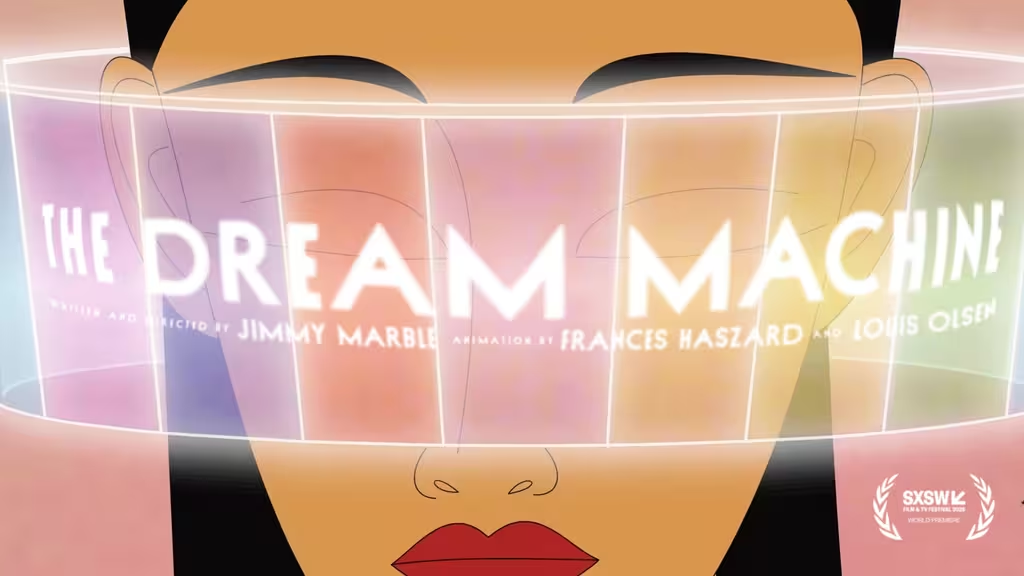🌙 The Dream Machine (2025) Watch Jimmy Marble’s enchanting animated short film & dive into a world of wonder. ✨ Watch now & be enjoyed.
🌙 The Dream Machine (2025) — Animated Short Film by Jimmy Marble
An elegant, eerie meditation on loss and escape, The Dream Machine uses animation’s supple language to chart a widow’s fragile passage through grief into—and through—virtual reverie. Jimmy Marble’s short plays like a lullaby that keeps slipping its tune. Unfolding in roughly eight minutes of luminous imagery and quietly urgent emotion.
🧭 Overview
- Genre: Animation · Drama · Sci‑Fi
- Director & Writer: Jimmy Marble 🎬✍️
- Format: Short (≈8 minutes) ⏱️
- Core cast (voice/portrayal): Susan Berger, Alina Cutrono, Nadav Heyman and collaborators 🎙️
- Tone: Dreamlike, melancholic, uncanny ✨
- Language: English (narration/voice)
- Key idea: A widow enters an advanced virtual program to cope with loss and discovers the boundary between comfort and captivity is thinner than she thought, more to know at IMDb.
Watch the short:
📖 Story in brief
A recent widow, still raw with absence, is offered a new kind of therapy: an immersive virtual “dream machine” that lets users relive, reconstruct, or reinvent memory. At first it’s a balm—warm reconstructions, small comforts, gentle resets.
Gradually, however, the simulations bend, asking more of her: trade-offs of authenticity, moments she never actually lived, and comforts that start to rearrange how she remembers the person she lost. The film follows her as the machine’s lush, seductive worlds collide with the stubborn ache of reality, forcing a choice between perfect illusion and messy truth.
🎨 Creative DNA & style
- Animation as feeling: Visuals are textured and tactile—handmade colors softened by digital glow—so memories feel both intimate and slightly unreal.
- Surreal shifts: Scenes slide between the domestic and the fantastic. A kitchen table becomes a starlit plain, a voicemail unspools into a coral reef of sound.
- Sound design as tether: Audio cues — a breath, a laugh, a creak — anchor emotional beats and make the virtual feel viscerally personal.
- Economy of story: In under ten minutes Marble trusts suggestion over explanation, letting small, specific images carry the emotional weight.
🌟 Themes & resonance
- Grief and substitution: Can technology give back what time has taken, or does it only offer a re‑arranged consolation?
- Memory’s mutability: The film asks how much of remembrance is construction—and whether constructed memories can become “real.”
- Ethics of escape: Comfort can be complicit; escape may cost authenticity and agency.
- Loneliness and connection: Even perfect simulations can’t fully replace the risk and warmth of human presence.
✅ What works and what may divide viewers
- Strengths
- 🎯 Emotional focus: A compact, affecting portrait of mourning that feels honest rather than melodramatic.
- 🎨 Visual imagination: Striking, memorable animated sequences that linger after the credits.
- 🔇 Subtlety: The film trusts silence and small details to do heavy lifting.
- Limitations
- ⏳ Short runtime: Viewers who crave full backstory or deeper world‑building may feel teased.
- 🌀 Ambiguous ending: The film’s refusal to spell everything out will delight some and frustrate others.
💡 Humanized takeaway
The Dream Machine is a gentle warning and a tender consolation: technology can hand you a softer version of loss, but sometimes the only way forward is to stand in the raw light of what actually happened. Marble’s short doesn’t demonize escape; it mourns the cost—and celebrates the fierce, imperfect freedom of choosing truth over perfect illusion.

